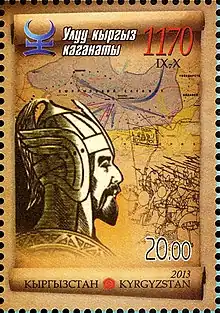Alp Sol Tepek
Alp Sol Tepek (Old Turkic: 𐰀𐰞𐰯 𐰽𐰆𐰞 𐱅𐰇𐰯𐰅𐰚, romanized: Alp Sol Töpek, Chinese: 塔布合族, Pinyin: Tǎbù Hézú) was a Tarkhan of the Yenisei Kyrgyz Khaganate who lived in the first half of the 9th century.
Töpek | |
|---|---|
 Alp Sol on a postage stamp of Kyrgyzstan | |
| Native name | |
| Born | 9th century |
| Died | 9th century Tuva |
| Allegiance | Yenisei Kyrgyz Khaganate |
| Years of service | 820–847 |
| Rank | Tarkhan |
| Memorials | Orkhon inscriptions |
Etymology
For the first time Alp Sol is mentioned in 842 in the Chinese source «Old Book of Tang» as «Tapu Hezu». In November 842, envoy Tapu Hezu arrived at the border fortress of the Tiandejun province from the Kyrgyz Khagan with a letter informing him that, having no information about the fate of the princess Taihe, the Khagan sent a military detachment to look for her. The Kyrgyz sent General Tapu Hezu and others to the fortress of the Tiande province, in addition, they announced that they would move to the Helo River to live in the old territory of the Uyghur Khaganate. In addition, five tribes submitted to them - Kuqa, Beshbaliq, Tatars and others. Emperor Tang rejoiced at the arrival of the Kyrgyz envoy and placed him above the envoy from Balhae.[1]
In the summer of 1915, Russian scientist Boris Vladimirtsov discovered a runic rock inscription in the Tes River Valley (Northwestern Mongolia). The original interpretation of the translation turned out to be incorrect, in 1969 and 1975 the Soviet scientist Sergei Klyashtorny conducted a thorough study and published the correct interpretation of the inscription.[2]
I, Töpek Alp Sol, wrote this. I was then in good health.
— Alp Sol Tepek
This inscription is connected with the conquests of the Yenisei Kyrgyz in the 840s.
Life
Little is known of Alp Sol's early life. In 840, he commanded the left wing of the Kyrgyz army during the siege of Ordu Baliq.[3] Alp Sol commanded a campaign in Tibet and East Turkestan in 840–843. In 843, the Tang emperor Wuzung expressed gratitude to the Kyrgyz Khagan for rescuing Princess Taihe.[1]
Dear Khagan, the Lord granted you a beautiful appearance and a formidable appearance. You have calmed everyone who lives in the great desert behind the fortress wall. You destroyed all the yurts and tents of the Uyghurs and justly took revenge. You have protected the residence of our princess and this merit of yours once again proves your sincerity towards us. You also sent your best minister to us, equipping him for a journey through the northern desert. Your horses and eagles have covered such distances and walked through such sands that all these efforts of yours, on the one hand, prove our relationship, on the other, my soul.
— Wuzong

In 842, Alp Sol conquered the tribal union of the Tatars, as evidenced by the runic inscription on the river Uibat.
Tatar weeping people. He gives aways his sisters. And our younger brothers are rewarded with women rejoice in this.
After the defeat of the Uyghur Khaganate in 840, the Kyrgyz faced the Mongol-speaking Tatars. The Kyrgyz, having defeated the hostile Tatars, captured as trophies their women, whose husbands fell in battle. According to custom, Tatar slaves became the property of Kyrgyz men.[4]
The so-called «Great Campaign» is reflected in the Kyrgyz epic Manas. In 842–843, Alp Sol, pursuing the surviving Tatars, invaded the Tang province of Gansu and plundered it, this is evidenced by a runic inscription found in Tuva.[5]
When I was fifteen, I went to meet the Tabgach Khagan. Thanks to my prowess as a warrior husband, with my heroism I captured gold and silver, camels and wives! Dying at the age of 67, the memorialist mourns the separation from his wife, whom he took at the age of 15.
— Ichreki Ter Apa
In 840–843, Alp Sol conducted a military campaign in East Turkestan, the purpose of which was to extend the power of the Kyrgyz Khagan in this region and to destroy the surviving groups of Uyghurs.[6] For 3 years, the Kyrgyz troops under his command captured the cities of Kuqa, Karasahr, Turpan and Beshbaliq, the tribes of East Turkestan were also conquered.[7][8] Kyrgyz detachments also conducted successful operations in the Tian Shan and Jeti Suu.[3]
In 843–847, the Kyrgyz conducted successful campaigns in Eastern Mongolia, Transbaikal and Western Manchuria. Alp Sol conquered the tribes of Transbaikal, Eastern Mongolia and carried out successful operations against the troops of Enian Qaghan and Wujie Qaghan.
Alp Sol made a significant contribution to the formation of a new nomadic empire, he led the conquests of the Kyrgyz in 840–847 and brought the Yenisei Kyrgyz Khaganate to its peak. He was a skilled diplomat and always defended the interests of the Kyrgyz state. His possessions were on the territory of modern Tuva.
Legacy
References
- "History of relations of Tang Empire and Kyrgyz Khaganate. Old Book of Tang". www.vostlit.info. Retrieved 2023-02-16.
- "The history of Central Asia and the monuments of runic writing - Klyashtorny S.G." djvu.online. Retrieved 2023-02-16.
- Osmonov, Oskon (2012). History of Kyrgyzstan – 10 class (in Russian). Bishkek, Kyrgyzstan: Insanat. ISBN 978-9967-452-32-9.
- Vasilyev, Ushnitskiy Vasiliy (2014). "The theory of the Tatar origin of the Yakuts" (1): 43–63. ISSN 2308-152X.
{{cite journal}}: Cite journal requires|journal=(help) - "S.G. Klyashtorny -Ancient Turkic runic monuments as a historical source". kronk.spb.ru. Retrieved 2023-02-16.
- Khudyakov, Yury Sergeevich; Medvedev, Vitaliy Egorovich (1980). Armament of the Yenisei Kyrgyz (in Russian). Publishing house "Science," Siberian branch.
- "History of Yenisei Kyrgyz – Yury Khudyakov". kronk.spb.ru. Retrieved 2023-02-16.
- "Yury Khudyakov – Kyrgyz in the vastness of Asia. Bishkek – 1995". Билим АКИpress (in Russian). Retrieved 2023-02-16.
- Tabyldy, Akerov (2011). "The Epic of Manas". ia-centr.ru (in Russian). Retrieved 2023-02-17.
- N.N., Taskarova (2011). ""Shadows of Ancestors" in Modern Khakass lyrics". The World of Science, Culture, Education (4–2): 127–129. ISSN 1991-5497.